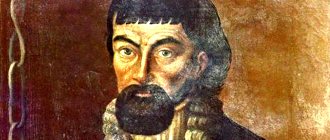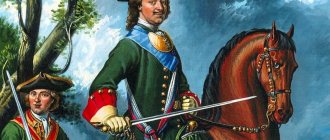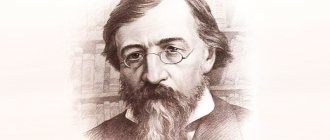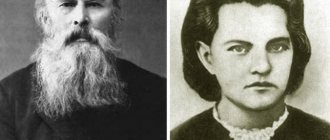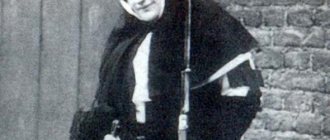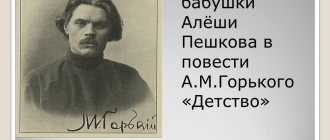History of creation
Writer Fyodor Dostoevsky
The image of Nastasya Filippovna was not inspired by Dostoevsky. The prototype for it was the writer’s longtime lover, Apollinaria Suslova. The daughter of a middle-class merchant, she was the sister of the first female doctor in Russia. Despite the age difference of 20 years, a romantic connection arose between Dostoevsky and Suslova. Apollinaria demanded from Dostoevsky a divorce from his wife and patronage in the literary field of her creations, which were not distinguished by talent. After the death of his wife, the writer decided to connect his life with his mistress, but she refused.
Literary scholars suggest that Apollinaria Suslova could become the prototype of Nastasya Filippovna, and confirm that the connection between two creative people was painful, nervous, almost inexplicable.
Dostoevsky's novel "The Idiot"
It is curious that Dostoevsky gave similar traits to the heroine of “The Idiot” to other characters. In The Brothers Karamazov, Agrafena Svetlova is endowed in a similar way, and in The Player, Polina is endowed. Many writers were inspired by the idea of the broken life of a simple Russian woman, creating images typical of Russian classical literature.
Behind the scenes, some writers, including Natalya Smirnova, who published the book “Nastasya Filippovna Syndrome,” characterize victims of violence with the name of the heroine, who are subsequently accompanied by psychological problems. By syndrome, the author of the term understands chronic hatred of all representatives of the stronger sex, which arises in parallel with the desire to be in demand and at the same time inaccessible.
Nastasya Filippovna's childhood years
Dostoevsky conveyed his experiences on paper and invested a lot in the images of what he himself experienced.
How I would like to dump the burden of my most painful memories onto a sympathetic reader.
Barashkova was born into a noble family. The officer's father went crazy after his mother's death. The girl was about seven years old at that time.
Soon the father died of fever.
The girl had no one left and the neighboring landowner Afanasy Totsky took upon himself all the care of the girl.
When Nastasya grew to the age when a girl is formed, Totsky suddenly discovered that she was turning into an extraordinary beauty.
He began to educate her even more diligently. Her tutors taught her French, music, and the rules of social etiquette.
Biography and plot
Nastasya Filippovna on the stage of the theater
Prince Myshkin first sees Nastasya Filippovna in a portrait image. The photograph impresses the hero so much that he cannot take his eyes off it, admiring the woman’s features. General Epanchin and Ganya Ivolgin, who were caring for her, did not immediately discern a rival in the prince. Myshkin, in turn, was able to discern from the photograph the wounded soul and tragic fate of Nastasya Filippovna. He is driven by deep compassion for a still unfamiliar person.
Since the age of 16, the girl has been living as a kept woman for the wealthy landowner Totsky. Given to him to be raised in her youth, she did not expect that her guardian would inflame her with more than just platonic love. By the age of 25, Nastasya Filippovna appears before the reader as Totsky’s mistress, who has experience of being in the world.
Prince Myshkin
By middle age, Nastasya Filippovna was no longer considered a girl, but the features inherent in infantile beauties remained with her. Narcissism and a certain masochism are justified by the fact that from a decent girl she turned into the concubine of a libertine. Now there is no bright spot in her life.
A woman with character, she is distinguished by bright outbursts of anger. Those around her are afraid of falling under her hot hand. Feeling like a complete loser, she allows herself to throw tantrums, demonstrating how deeply offended she was. Totsky, who was attracted by the appearance of his ward, considers her “colorful.” However, the heroine’s actions are predictable and monotonous. She curses her life, presenting herself as a fallen woman, conflicts with men and takes revenge for her lost honor.
Ganya Ivolgin (still from the film)
Nastasya Filippovna presents a one-man theater to the readers, showing up to Ivolgin, turning her own birthday into a booth, exposing herself as an insulted innocence. She condemns Totsky, who gives a large dowry for her to ensure a successful marriage, and ridicules the likely groom, Ganya Ivolgin. The girl throws the money offered to her by Rogozhin into the fire and forces Ivolgin to climb into the flames after them. Malice and anger drive her every action.
The energetic and strong-willed heroine finds herself in a vicious circle. Unable to experience other feelings, she does not understand what she wants and what she is striving for. A woman lives in the past, fixated on her own misfortunes and using them as excuses.
Prince Myshkin and Rogozhin
Few people remember that Nastasya Filippovna’s last name is Barashkova. Drawing an analogy with Rogozhin, one can understand that the names of the heroes are “speaking”. A man pursues his beloved like a predator prey. It seems that Rogozhin ends the woman’s life with his knife, but in fact it ended long before her physical death. Aglaya, who offered to reconcile with the situation, did not understand that for Nastasya Filippovna there was no longer a future.
It was no coincidence that Dostoevsky chose a woman who was aware of the tragedy of her fate as the main character. The writer endowed her with dreaminess and naivety, adjacent to eccentricity and hysteria. He saw in this woman a strong and firm character, which was sung in the work. Heroines like Nastasya Filippovna are present in every work of Dostoevsky. A description of similar destinies can be seen in both “Poor People” and “White Nights”.
Emotional dreamers living in a dream world are associated with the writer’s wife, who in the last years of her life was bedridden and existed in constant oblivion.
Nastasya Filippovna Barashkova
All the men in the novel are trying to win the affection and favor of Nastasya Filippovna. Epanchin, Ivolgin, Rogozhin - they all bribe Nastasya Filippovna. The latter does not take into account that she burned the money, which means she is not guided by material interests.
Only Myshkin understood the woman’s deep emotional trauma. He saw in Barashkova a living nature, suffering, wounded by emotional experiences. Tossing between the imperious and hot-tempered Rogozhin and the modest Myshkin, the woman promises herself to first one, then the second. The story ends with her death at the hands of the jealous millionaire merchant Parfen Rogozhin.
Ganya Ivolgin
Only Prince Myshkin could see the suffering, vulnerable soul in Nastasya Filippovna. For others, it was a subject of bargaining. Having learned that Totsky is going to marry one of the daughters of General Epanchin, Nastasya comes to St. Petersburg. And now the landowner sees: in front of him is not a touching, defenseless creature whom he destroyed, but a woman ready to take revenge. She has a terrible, infernal charm that attracts new fans. Among them is Ganya Ivolgin.
This young nobleman is rich, has a decent appearance, and is well educated. He is not stupid, but at the same time he has neither talent nor abilities, he does not have a single idea of his own. Ganya Ivolgin is “decidedly like everyone else.” He serves as General Epanchin’s secretary, and it is from him in one of the first chapters that Prince Myshkin sees a portrait of Nastasya Filippovna, which amazes him so much.
Film adaptations
The role of Nastasya Filippovna is a fertile choice for the actress, allowing her to reveal the full dramatic potential of the performer in a classic female image.
Still from the film “The Idiot” by Akira Kurosawa
In the first film adaptation of the novel, directed by Pyotr Chardynin in 1910, the role of the kept woman Barashkova was played by Lyubov Varyagina. The German film star Asta Nielsen embodied the image of a fallen woman in the film “Unfaithful Souls” by Karl Fröhlich in 1921, and the Frenchwoman Edwige Feuer starred in a video interpretation by Georges Lampin in 1946.
Japanese director Akira Kurosawa in 1951 presented to the public an adaptation of Dostoevsky's novel, in which the main character was named Taeko Nasu. She was played by Setsuko Hara. In the 1958 Soviet production, Yulia Borisova appeared as Nastasya Filippovna. 20 years later, when Alexandra Remizova staged a television play based on the novel “The Idiot,” Lyudmila Maksakova played in it.
Lyudmila Masakova as Nastasya Fillipovna
The Japanese film is not the only project where the director decided to change the name of the main character. Andrzej Zulawski, who directed Sophie Marceau in the 1985 film Crazy Love, gave her heroine the name Marie.
The film “Down House” by Roman Kachanov, based on the novel by Dostoevsky, turned out to be modern and in demand. In Russia, the actress Lydia Velezheva, who starred in Vladimir Bortko’s film “The Idiot,” performed in a feature-length film as Nastasya Filippovna.
Lidiya Velezheva as Nastasya Barashkova
It is curious that the name Nastasya Filippovna went to the wife of Dobrynya Nikitich, a brave young man from the “Three Heroes” cartoon series.
Prince Myshkin
One day, in a train carriage heading from Switzerland to Russia, Parfen Rogozhin meets a young man, rather strange, but arousing boundless sympathy and trust - Prince Myshkin. A distant relative of General Epanchina is very ill; he spent many years abroad, but treatment did not completely relieve him of his illness. It is from Rogozhin that Myshkin first hears about a woman named Nastasya Filippovna.
Dostoevsky's most famous hero is free from passions that destroy the human soul. He is like a child. His view of others is unclouded. That's why they call him an idiot. He is the only one who sees in Nastasya Filippovna not a fallen fatal beauty, but just an unhappy woman - a woman devoid of love and understanding. He feels sorry for her, perhaps he truly loves her. However, he is unable to bear the intrigues that a million-dollar inheritance that has fallen out of the blue gives rise to.
The author endowed Prince Myshkin with autobiographical features. The hero suffers from epilepsy, just like his creator. And it was Myshkin who told readers about the psychological state of a person before the death penalty - about what Dostoevsky knew from his own experience. Let's return to the image of Nastasya Filippovna. What role did the story of the “fallen woman” play in the fate of the unfortunate Prince Myshkin?


